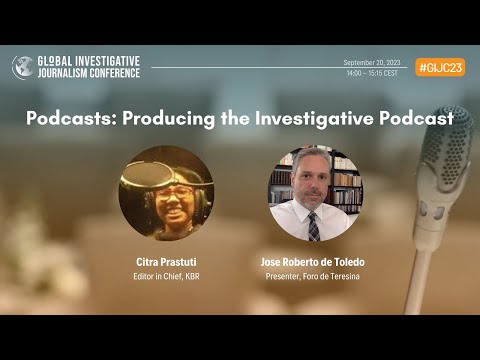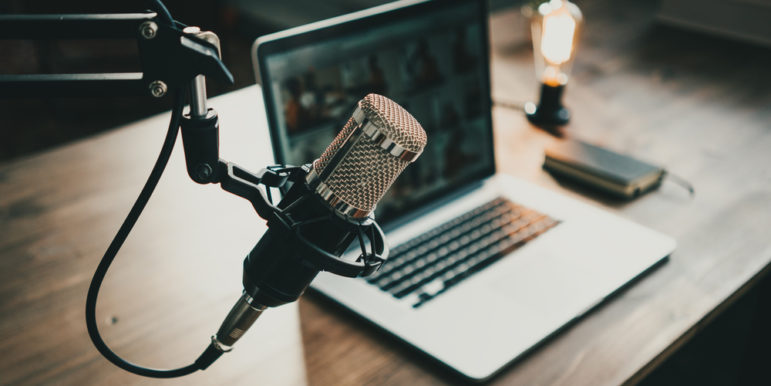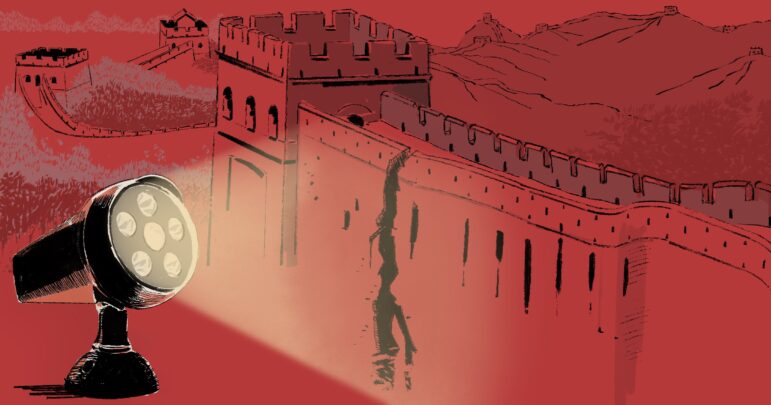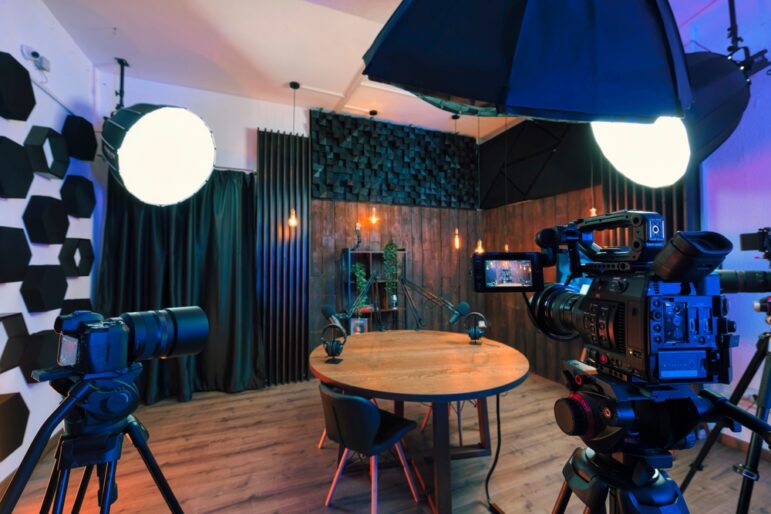

Image: Shutterstock
6 Tips for Launching an Investigative Podcast
Read this article in
Though investigative journalism stories are just a drop in the vast ocean of podcasts available on a huge array of platforms, investigative podcasts, which combine deep reporting with audio storytelling techniques, have become more widespread.
GIJN’s annual worldwide selection of the best investigative podcasts notes innovation in the form, such as incorporating video, and the growing influence of podcasts in the political arena. Investigative outlets and journalists have drawn new audiences by producing narrative podcasts — but it can be daunting to get started, or to know how to package complex reporting and data into compelling audio.
At this year’s Dataharvest conference in Mechelen, Belgium, Piotr Nesterowicz, producer for Pismo Investigation, a podcast developed by Polish investigative magazine Pismo, and Ricardo Esteves Ribeiro, co-founder of Portuguese podcast studio Fumaça, shared their experiences creating compelling investigative audio. In a session titled By Word of Mouth: Producing Investigative Podcasts, they discussed how they select topics for investigative podcasts, how to keep audiences coming back, and the business models that have made theirs a success. GIJN has distilled their advice into six tips for getting started.
1. Think ‘Serial’ — Decide on Series vs. Standalone
The podcast format is well-suited to investigative journalism because there is room to tell complex stories with few limits on length. When they decided to produce their first investigative podcast in 2019 — then a niche format for journalism in Poland — Pismo decided to tell a story through a series of episodes, rather than a standalone podcast, and has never looked back. The fifth season of Pismo Investigation was released in April 2024 and examined — in six 50-60-minute episodes — several aspects of a story about the case of a young woman who was harassed by a stalker. Episodes explored stalkers’ manipulation tactics, victims’ feelings of hopelessness, and the difficulty of obtaining justice for such incidents through Poland’s legal institutions.
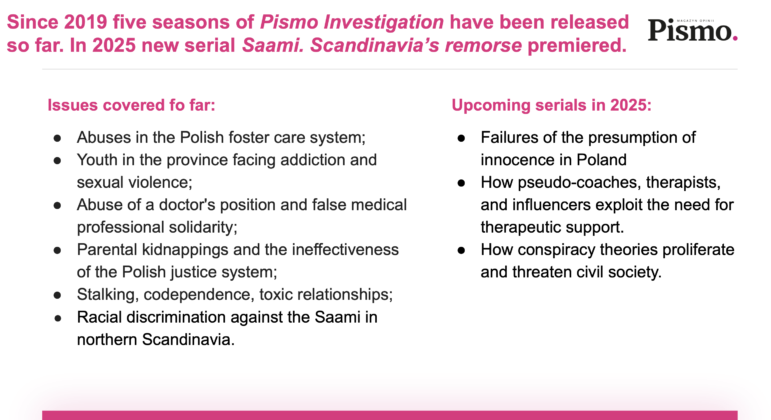
The Polish investigative podcast, Pismo, has covered a number of challenging topics since debuting in 2019. Image: Courtesy of Pismo
Their investigative series “allows us to [distinguish ourselves from the thousands of podcasts you have everywhere,” said Pismo Investigation producer Nesterowicz. “As it takes a lot of time and effort, it is hard for independent [journalists] to do it. As for big players, they don’t bother.”
Originally a print magazine offering high-quality and in-depth journalism, Pismo now produces up to three podcast seasons every year, covering complex and sensitive topics such as parental kidnappings and abuse of power by medical professionals. The episodes of all seasons have reached around 330,000 unique listeners, according to their website.
The podcast also reached an unexpected audience, noted Nesterowicz: “The press and news avoiders — mostly young people, women, and people from lower socio-economic classes who consider traditional news outlets ‘not for people like them.'”
Lisbon-based Fumaça was audio-focused from the very start in 2016, “because two members of the team were musicians, so they had the material,” joked co-founder Esteves Ribeiro. With a focus on injustice and inequality and the capacity to report deeply on complex topics — such as by launching a call for testimonies about police violence published on the internet and interviewing hundreds of people for hours, if not days — serializing their podcast was always the priority.
2. Steal Storytelling Techniques from Entertainment/Fiction
Don’t be afraid to use techniques from fictional or dramatic entertainment. “The investigative and research parts are important, but as a journalist, you know how to do [those things]. The difference is the storytelling,” said Nesterowicz.
As long as the reporting and the story is there too, he explained don’t hesitate to steal narrative tricks from entertainment: “Cliffhangers, changes in situation, surprises, and so on… We do all of that and put a lot of effort into telling the story. It’s fact-based, but you can play with the audience to engage,” he adds.
Of course, it all begins with having the right story. “There are things you can investigate, but not necessarily communicate in an investigative podcast format,” explained Nesterowicz. Pisco chose to keep their print and audio outputs separate. Their criteria for selecting stories that would make good podcasts are whether there is a hero in that story. Sometimes the journalist telling the story is the hero.
Esteves Ribeiro also advocates capturing the audience with narrative threads, such as the process of obtaining a document: “Tell your audience ‘we went here and no luck’ and then there and ‘no luck’… People will trust you more if you are transparent with the process, and they will want to go to the story until the end,” he said.
“Fronteira do medo” (“Border of Fear”), Fumaça’s forthcoming podcast series, investigates policing and surveillance of ghettoized neighborhoods. Like a true crime podcast, it starts with the story of a killing. “The difference between a true crime podcast and a podcast beginning with a crime is the investigation,” said Esteves Ribeiro. The audience is told in the very first episode that: “This is an investigative journalism project about how the story of that night is bigger than the story of that night.” With 14 episodes of over one hour long, Fumaça’s goal was to investigate Portugal’s racialized policing in sensitive urban areas. “Because we are obsessive, it took us six years,” he added.
The telling is not the same in every episode: the first episode tells two different versions of what happened that night — what the people say, and what the police say. Another episode is a long interview with the inspector general of police, while another is based only on an audio archive.
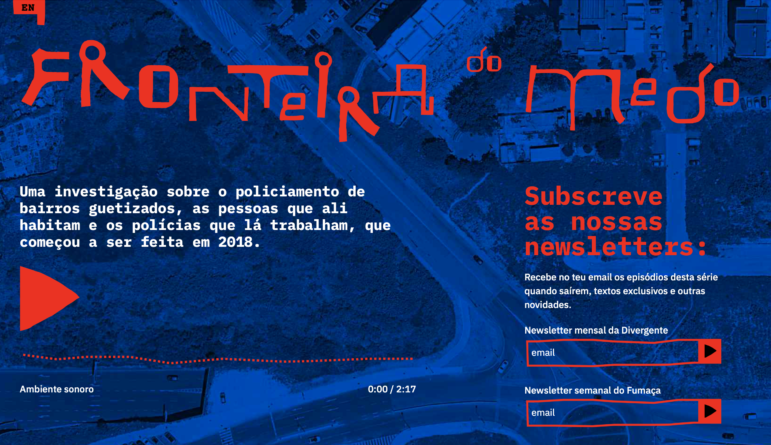
Fumaça’s new Fronteira de Medo podcast investigates policing and surveillance of ghettoized neighborhoods. Image: Screenshot, Fumaça
3. Keep the Recorder On
Esteves Ribeiro advises keeping the recorder on as much as possible. “Even when you are knocking on the door, record it. Maybe you won’t use it, but maybe in the future, you will need it.” For any interview, he also recommends recording from the very start. Nesterowicz agrees: “When recording from the beginning, you capture emotions that can not be recreated.”
Esteves Ribeiro shared a useful tip for collecting audio material: exploiting voice messages. “With sources, you cannot interview a person every single day, but you can ask them to send you a voice message every single day,” he explains. He has collected — for another potential story — hundreds of voice messages from a couple trying to cross the Mediterranean Sea from Libya to Greece.
He recommends using the same technique with your colleagues: “For example, you go to court to check some documents in court. When you leave the court, send a voice message to your colleague, saying what you saw and what was interesting… Maybe you’ll use it, maybe not, but it’s there.”
4. Keep The Story Fresh
Producing several episodes of an investigative podcast allows you to tell a story with depth. But Nesterowicz warned that deep reporting needs to be balanced with making the story accessible to listeners. “Keep in mind that people often listen episode by episode, and are not necessarily binge-listening. If you have too many names and figures, people will get lost. Be careful not to overcomplicate a story.” He always makes sure to have the fresh eye of someone in the newsroom who isn’t familiar with the story.
5. Different Business Models
Financing a podcast program can involve various models, and the Dataharvest panelists demonstrated this by opening up about their funding methods.
For Pismo, producing one investigative podcast season (six to eight episodes) costs around €20,000 (US$23,000), not including staff salaries. Pismo has a paywall and is financed by a major private donor. They give free access to the first episode of the podcast, then a subscription, either to Pismo or to their production partners, Audioteka Klub, is needed to keep listening. A monthly subscription to all Pismo content is 9.99 Polish zlotys, or $US2.71.
Fumaça spends, more or less, €25,000 (US$29,000) per month for a team of 11 people. Half of their budget comes from subscriptions, and the other half from three foundations. All their content is free to access.
6. Go For It!
Podcasts offer a unique intimacy between people narrating a story and people listening. Esteves Ribeiro and Nesterowicz agree that, aside from storytelling, the quality of the audio production is important. While Pismo cooperates with external partners, Fumaça built its own studio.
“It is usually better if you have good audio and good tape,” said Esteves Ribeiro. But he cites Fumaça’s first-ever podcast, the six-episode documentary “Palestina, histórias de um país ocupado”/ (“Palestine, stories of an occupied country”) published in 2017. “We recorded everything with a phone… and we won the biggest journalism award in the country,” he recalled. “I would never do that today… but just go and try. You can build a studio, but you don’t have to.”
 Alcyone Wemaëre is a French journalist based in Lyon since 2019. She is a former staff reporter of France24 and Europe1 in Paris. Along with being GIJN’s French Editor, she is an associate professor at Sciences Po Lyon, where she is co-responsible for the master’s degree in journalism, “data and investigation” specialty, created with CFJ. Alcyone graduated from Celsa and received the François Chalais Prize. Her work has also appeared in Le Monde, Slate, Infomigrants, La Chronique (Amnesty International), L’Obs, and Le Temps.
Alcyone Wemaëre is a French journalist based in Lyon since 2019. She is a former staff reporter of France24 and Europe1 in Paris. Along with being GIJN’s French Editor, she is an associate professor at Sciences Po Lyon, where she is co-responsible for the master’s degree in journalism, “data and investigation” specialty, created with CFJ. Alcyone graduated from Celsa and received the François Chalais Prize. Her work has also appeared in Le Monde, Slate, Infomigrants, La Chronique (Amnesty International), L’Obs, and Le Temps.

